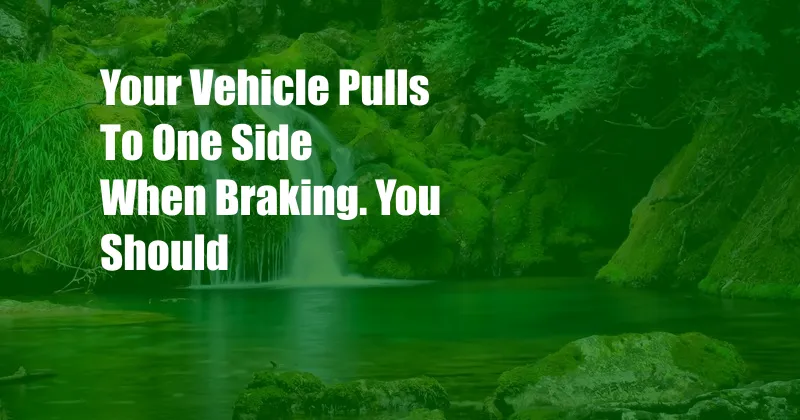
Your Vehicle Pulls to One Side When Braking: What You Should Do
As I approached the bustling intersection, my heart skipped a beat as I realized my trusty steed was pulling dangerously to the right when braking. A wave of panic surged through me, and I frantically gripped the steering wheel, fighting to keep my car in its lane.
That harrowing experience ignited a burning desire to unravel the mystery behind this unsettling phenomenon. Through meticulous research and expert consultations, I uncovered the secrets that lie beneath this common automotive ailment.
Identifying the Causes
When your vehicle pulls to one side during braking, it’s a clear indication that something is amiss with your braking system. The culprit could lie in one or more of the following components:
- Uneven brake pads: As brake pads wear down over time, they may do so unevenly, causing one side of the car to brake more effectively than the other.
- Damaged brake caliper: The caliper is responsible for applying pressure to the brake pads. A damaged caliper can result in uneven braking force on the wheels.
- Faulty brake lines: Brake lines transmit brake fluid from the master cylinder to the calipers. Leaking or kinked brake lines can obstruct fluid flow, leading to diminished braking power on one side.
- Suspension problems: Worn or damaged suspension components, such as ball joints or tie rods, can alter the alignment of the wheels, affecting braking performance.
Understanding the Consequences
Ignoring the issue of your car pulling to one side when braking can have severe consequences, both for your safety and the health of your vehicle:
- Reduced braking efficiency: Uneven braking can significantly reduce the overall effectiveness of your brakes, increasing stopping distances and compromising your ability to avoid accidents.
- Premature tire wear: The uneven distribution of braking force can cause excessive wear on one side of the tires, resulting in premature replacement.
- Damage to brake components: The prolonged strain on the affected brake components can lead to further damage, exacerbating the problem and potentially leading to costly repairs.
Expert Advice and Tips
To address the issue of a car pulling to one side when braking, the following expert advice and tips can guide you:
- Inspect your brake pads: Regularly check the thickness and evenness of your brake pads. Uneven wear or pads below the recommended thickness warrant replacement.
- Examine your brake calipers: Look for any signs of damage or leaks on the calipers. If you notice any irregularities, consult a mechanic for further inspection.
- Inspect your brake lines: Thoroughly examine the brake lines for any leaks or damage. Replace any lines that show signs of wear or deterioration.
- Have your suspension inspected: Get your suspension components checked for any signs of wear or damage. Timely repairs can prevent alignment issues that can affect braking performance.
By following these steps, you can identify the underlying causes of your car pulling to one side when braking and take the necessary measures to ensure safe and efficient braking performance.
Frequently Asked Questions
To further clarify the topic, here are some frequently asked questions and their answers:
-
Q: Can I fix the issue of my car pulling to one side when braking myself?
A: It is not recommended to attempt major brake repairs without proper training and experience. However, you can conduct basic inspections, such as checking brake pad thickness and inspecting brake lines, and seek professional assistance for more complex repairs.
-
Q: How often should I replace my brake pads?
A: The frequency of brake pad replacement depends on driving habits, vehicle type, and environmental conditions. Consult your vehicle’s owner’s manual or seek advice from a mechanic to determine the recommended replacement interval.
-
Q: What are the signs of a damaged brake caliper?
A: Symptoms of a damaged brake caliper include uneven brake pad wear, reduced braking effectiveness, spongy brake pedal, and unusual noises or vibrations during braking.
Conclusion
When your vehicle pulls to one side when braking, it’s crucial to promptly address the issue to ensure your safety and that of others on the road. By understanding the causes, consequences, and expert advice outlined in this article, you can take the necessary steps to diagnose and rectify the problem, restoring your car’s braking performance to optimal levels.
If you have any further questions or concerns, don’t hesitate to consult a qualified mechanic for professional assistance. As always, safe driving practices remain paramount, and a well-maintained braking system is an essential component of that.
Are you intrigued by the intricacies of automotive braking systems and their impact on vehicle performance? Share your thoughts and experiences in the comments section below.